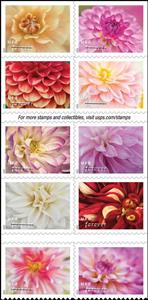Se-tenant: Dahlias (United States of America 2025)
Dahlias (United States of America 2025)
26 April (United States of America ) within release Dahlias (2025) goes into circulation Se-tenant Dahlias face value 10*FOREVER No Face Value
| Se-tenant Dahlias in catalogues | |
|---|---|
| Colnect codes: | Col: US 2025.04.26-01 |
Se-tenant is square format.
Issued in double-sided booklets containing two sets of ten designs. Face value US$0.73 per stamp on day of issueAlso in the issue Dahlias (2025):
- Se-tenant - Dahlias face value 10*FOREVER;
- Booklet - Dahlias face value 20*FOREVER;
- Stamp - Dahlias face value FOREVER;
- Stamp - Dahlias face value FOREVER;
- Stamp - Dahlias face value FOREVER;
- Stamp - Dahlias face value FOREVER;
- Stamp - Dahlias face value FOREVER;
- Stamp - Dahlias face value FOREVER;
- Stamp - Dahlias face value FOREVER;
- Stamp - Dahlias face value FOREVER;
- Stamp - Dahlias face value FOREVER;
- Stamp - Dahlias face value FOREVER;
- Stamp - Dahlias face value FOREVER;
- Stamp - Dahlias face value FOREVER;
- Stamp - Dahlias face value FOREVER;
- Stamp - Dahlias face value FOREVER;
- Se-tenant - Dahlias face value 10*FOREVER;
- Stamp - Dahlias face value FOREVER;
- Stamp - Dahlias face value FOREVER;
- Stamp - Dahlias face value FOREVER;
- Stamp - Dahlias face value FOREVER;
- Stamp - Dahlias face value FOREVER;
- Stamp - Dahlias face value FOREVER;
- Stamp - Dahlias face value FOREVER;
- Stamp - Dahlias face value FOREVER;
- Stamp - Dahlias face value FOREVER;
- Stamp - Dahlias face value FOREVER;
Se-tenant Dahlias it reflects the thematic directions:
A flower, sometimes known as a bloom or blossom, is the reproductive structure found in plants that are floral (plants of the division Magnoliophyta, also called angiosperms). The biological function of a flower is to effect reproduction, usually by providing a mechanism for the union of sperm with eggs. Flowers may facilitate outcrossing (fusion of sperm and eggs from different individuals in a population) or allow selfing (fusion of sperm and egg from the same flower). Some flowers produce diaspores without fertilization (parthenocarpy). Flowers contain sporangia and are the site where gametophytes develop. Many flowers have evolved to be attractive to animals, so as to cause them to be vectors for the transfer of pollen. After fertilization, the ovary of the flower develops into fruit containing seeds. In addition to facilitating the reproduction of flowering plants, flowers have long been admired and used by humans to beautify their environment, and also as objects of romance, ritual, religion, medicine and as a source of food.

